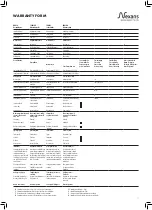
4
English
Installation Instructions N-HEAT
®
MILLIMAT™
Important! Read this before starting the installation
Please read through the entire installation instructions (this document) before
starting the installation.
Plan the installation by identifying the heated area, which is the entire room area
minus areas not to be heated.
• The heating cable cannot cross neither touch itself and cannot be placed in
a wall, therefore the area of the MILLIMAT(S) must be slightly smaller than
the heated area.
• The distance between the mat and any thermal barrier shall be minimum 3 cm
(1,2 inches).
• Do not install the mat under permanent installations without legs. This will
prevent airflow and may cause overheating.
• In floors requiring membranes (wet rooms), the membrane should preferably
be placed above the mat
• In case some cable is removed from the net and laid freely, the same CC
distance as on the net shall be observed and used.
• Any reinforcement net or bars installed above the MILLIMAT must be
installed in such a way that the cable is not damaged during subsequent
works.
General guidelines
The installation of this heating product shall be in accordance with the manu-
facturer’s instructions and the regulations of the authority having jurisdiction. The
product should only be installed only by qualified personnel who are familiar
with the construction and operation of heating cables and the risks involved.
Product description
Twin conductor heating cable mat designed for electrical floor heating, sup-
plied with factory fitted cold lead (length 2,5 m). The cable is terminated with a
water tight end seal.
Technical data
Conductor insulation:
Fluor polymer
Outer sheath:
PVC
Power:
As stated on cable/package (Watt)
Rated voltage:
230V~
Max. operating voltage:
500V
Max. cont. operating temp.:
65 °C (149 °F)
Minimum bending diameter:
40 mm (1 5/8”)
Min. bending diameter
10 x cable diameter
Resistance tolerance:
- 5% / +10%
Length cold lead:
2,5 m
Mechanical class:
M1
Minimum installation temperature:
0 ºC (32 ºF)
Application
The MILLIMAT is suitable for heating all types of indoor rooms and well suited
for renovation projects. The MILLIMAT is designed for embedding in adhesive/
mortar/screed/concrete and can be installed beneath most floor coverings,
please see these instructions for further details. MILLIMAT 150 W/m² can only
be installed on a non-combustible subfloor, while MILLIMAT 100 W/m² is
approved for installation on combustible surfaces.
Installation instructions – step by step
1.
Caution! Handle the product with care and do not press or drop sharp
objects into the MILLIMAT.
2.
Measure and check the following electrical properties to be within limits
before installing the MILLIMAT:
- The ground insulation between the earth wire and the resistance wires:
100 MOhm or higher.
- The resistance value of the heating element: Within -5/+10% of nominal
value.
Enter the results into the warranty form.
3.
It’s recommended to treat the sub floor with a primer so that mat can be
easily fixed to the underlay. Apply the primer with a brush, and leave to
dry. Do NOT apply a primer later on, after the heating cable mat has been
installed, as this might dissolve the adhesive on the net.
- MILLIMAT 100 W/m² can be installed on any type of stable and leveled
sub-floor.
- MILLIMAT 150 W/m² must be installed on a non-combustible sub-floor
(leveled and stable) with minimum thickness 5 mm.
4. IMPORTANT!
Please investigate if the cold lead attached to your heating mat/cable has
got a hidden splice marked with -> SPLICE <-, or a manual splice identified
as a bulge on the cable:
Manual Splice
Splice
Splice
SPLICE
** Cold Lead **
Hidden/integrated Splice
Manual Splice
Irrespective of SPLICE type, the SPLICE has to be placed embedded into the
heated floor, and NOT inside the wall or other non-heated area:
Install and adjust the MILLIMAT by rolling out the mat on the sub-floor.
Beware! When making adjustments: Do not cut the cable, only the net.
MILLIMAT is self-adhesive, and is fixed by applying a light pressure. When
cutting and adjusting the mat, ensure that the cables are kept at the same
distance from each other as the cables on the mat itself. Make sure that the
splice (the connection between cold and hot part of the cable) is placed so
the cold lead reaches the thermostat, and that the splice itself is placed in the
floor and not inside the wall.
The end seal shall never be placed under permanent installa-
tions.
If other cables (which are not a part of the heating cable installation) are
embedded in the heated floor these must be placed at least 3 cm (1,2
inches) away from any heating cable. The current-carrying capacity of these
cables must be adjusted due to the heated surroundings. If a floor sensor is
used it must be connected at equal distance between two cable strands. It’s
recommended to install the floor sensor inside a tube, making it possible to
replace it in the future.
5.
Measure the ground insulation and conductor resistance again before
pouring the adhesive/screed/mortar/concrete. Enter the results into the
warranty form. Avoid stepping on the cable and be careful during further
works and embedding. Remember that while the cable is installed but not
yet embedded, it is exposed and somewhat vulnerable.
6.
When embedding, use cement-based tile adhesive, thinset mortar, screed or
concrete, with good heat conductivity suitable for heated floors. During the
pouring of the floor, the heating cable must be protected against potential
mechanical damage, e.g. from concrete truck hose, buckets, tools etc.
The following requirements to heat conductivity must be met:
• For traditional cement based mortars the minimum requirement is 1.0 W/mK.
• For screeds and other special mortars, the minimum requirement is
0.6 W/mK with a maximum of 3 cm. molding thickness. For thicker floors,
the requirement is the same as for traditional cement based mortars.
The heating cable must be embedded with minimum 5 mm (0,2 inches)
concrete above the cable when the top floor covering is tile or stone. The
minimum thickness above the cable is 10 mm when the top floor covering is
vinyl, linoleum, carpet, engineered wood or other. As a minimum, the
MILLIMAT must be covered entirely by the adhesive/screed/mortar/con-
crete, but a thicker layer might be required to ensure mechanical floor stabil-
ity.
Use machinery / a power tool to mix well and pour shortly
after mixing.
Follow the guidelines given by the manufacturer and ensure
that the MILLIMAT is fully embedded. Any additive/filler (e.g. metal fibers)
must be of such a nature that it cannot inflict any damage on the cable.
After pouring, compact well to avoid air pockets and a porous slab. The
concrete must embed the cable entirely to ensure sufficient heat conductivity
from the cable to its surroundings. Good heat conductivity is important for
the function of the floor, but also to prevent excessive temperatures. Some
concrete types can be mixed with reduced amounts of water as specified
by the vendor. In these cases, pay special attention to the mixing and the
compacting as these floors easily become porous and thereby thermally
insulating.
The heating cable is not to be used before the concrete has dried and cured
naturally. This can take up to 6-8 weeks. In renovation projects special
screeds for thin floors are often used, and these may have a shorter curing
period. Please consult the instructions/guide provided by the vendor of the
concrete.
7.
Install the top floor
Area power specific rules
MILLIMAT 100 W/m² can be installed beneath most types of floor covering.
That includes wood, laminate, parquet, vinyl, tiles, slate, stone, marble, etc.*
Summary of Contents for N-HEAT MILLIMAT
Page 2: ...2 ...





































